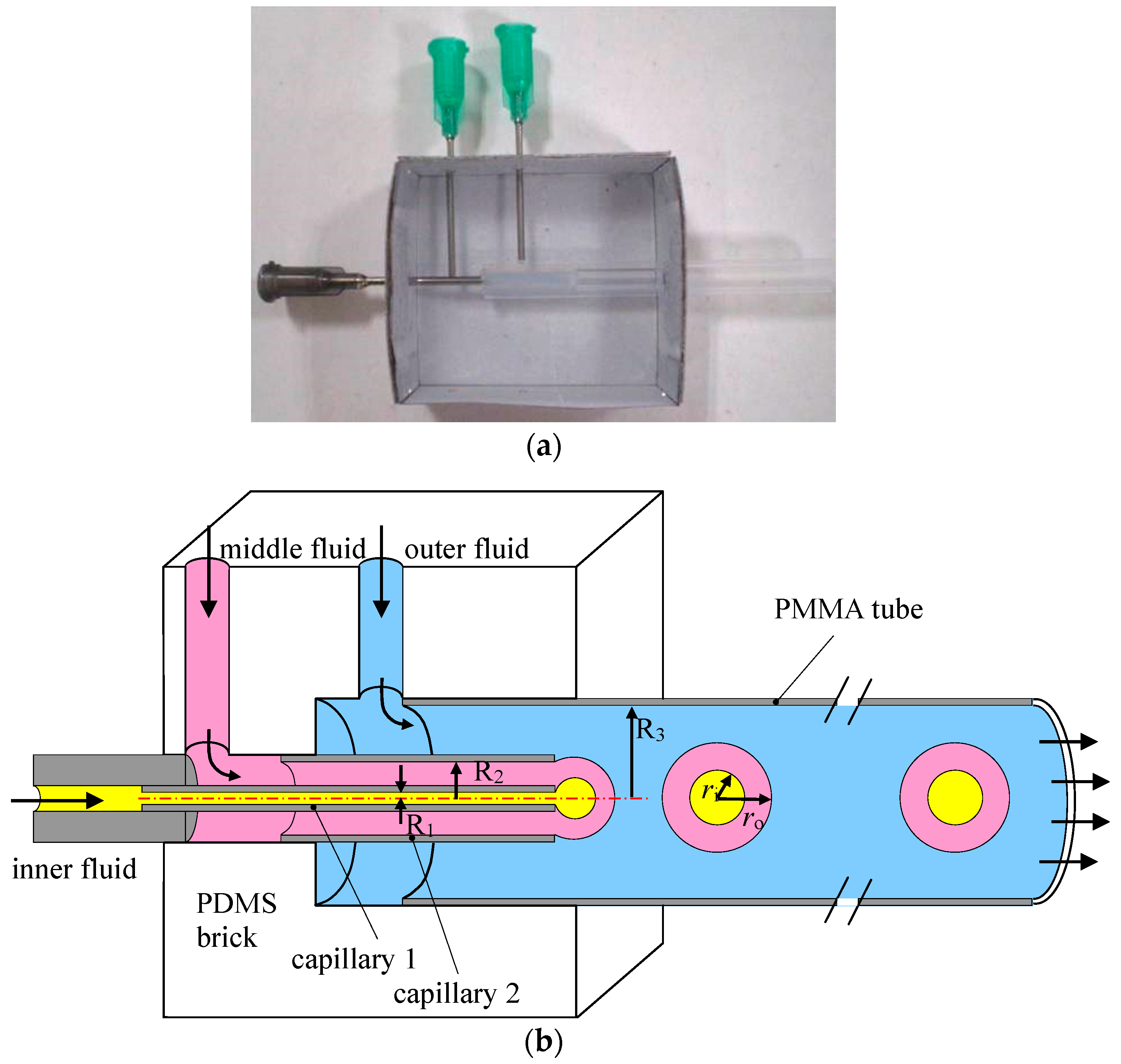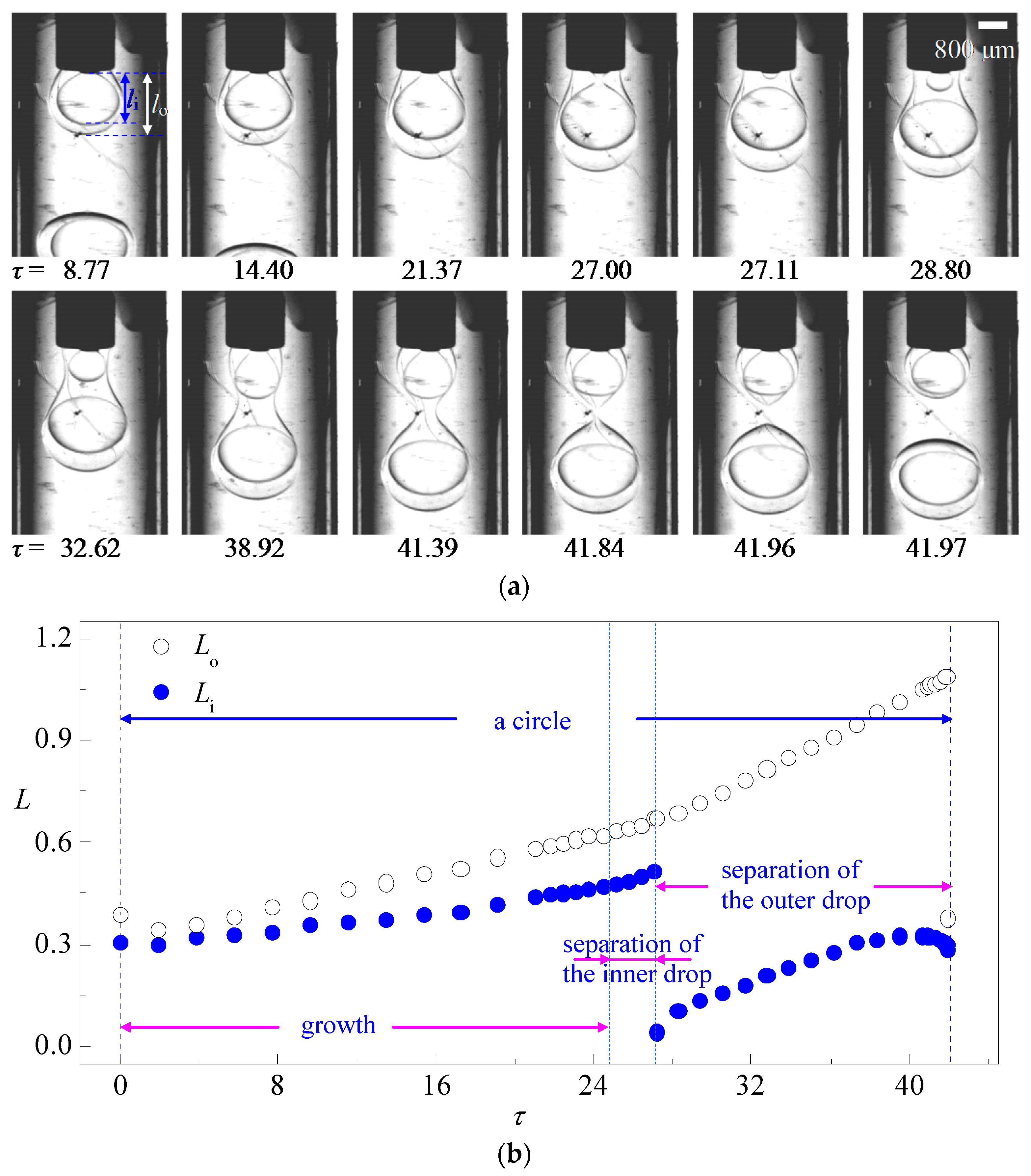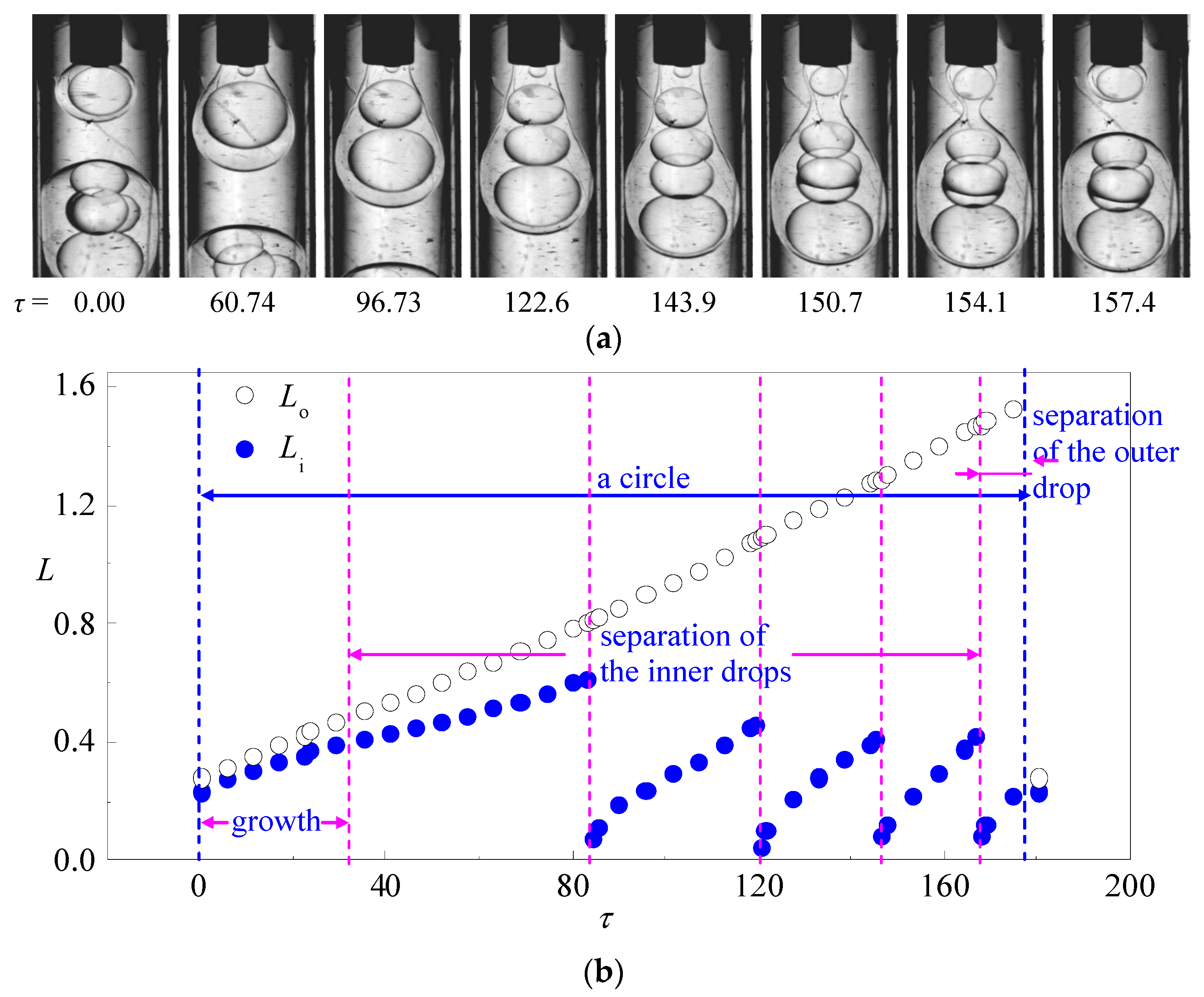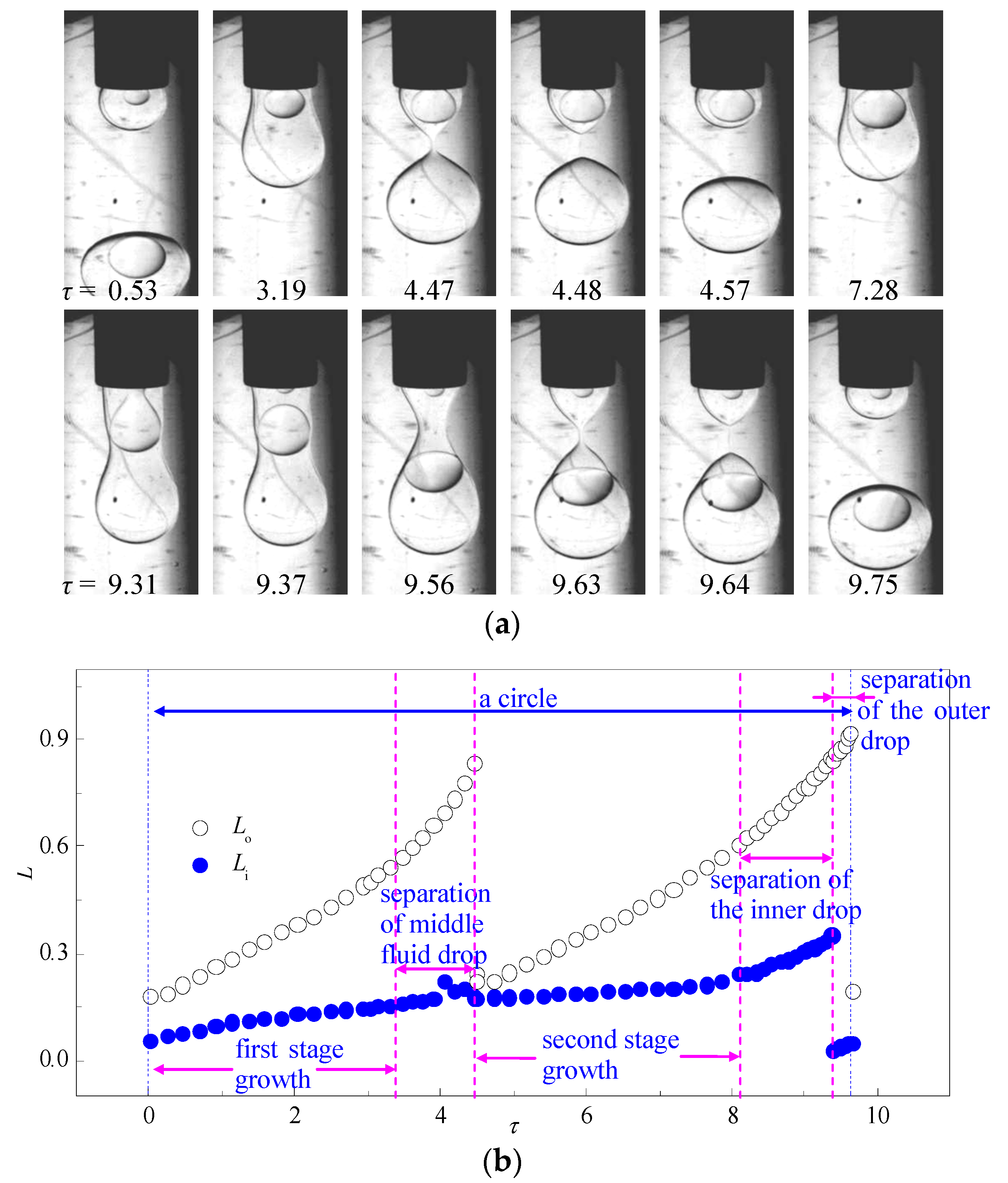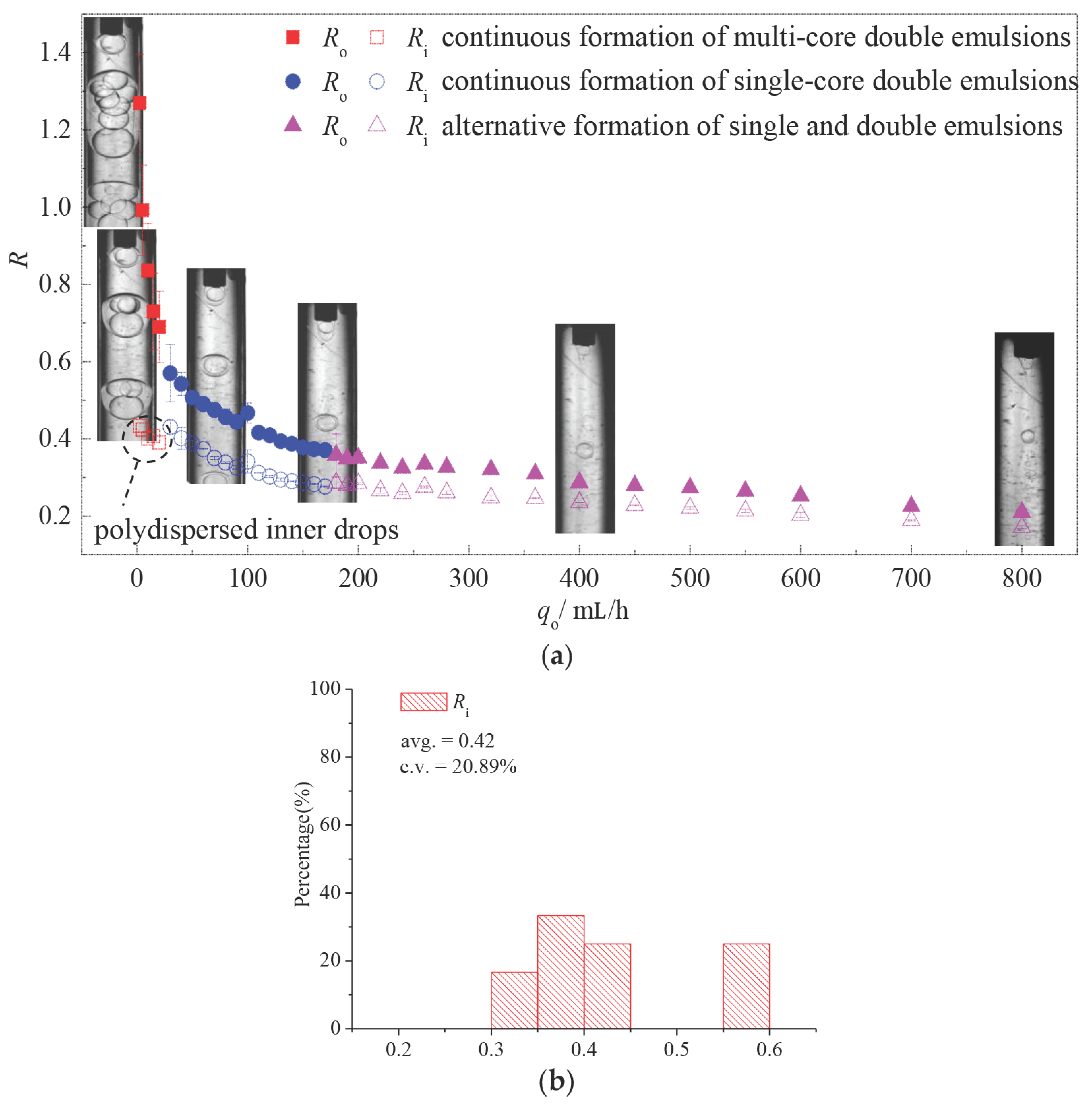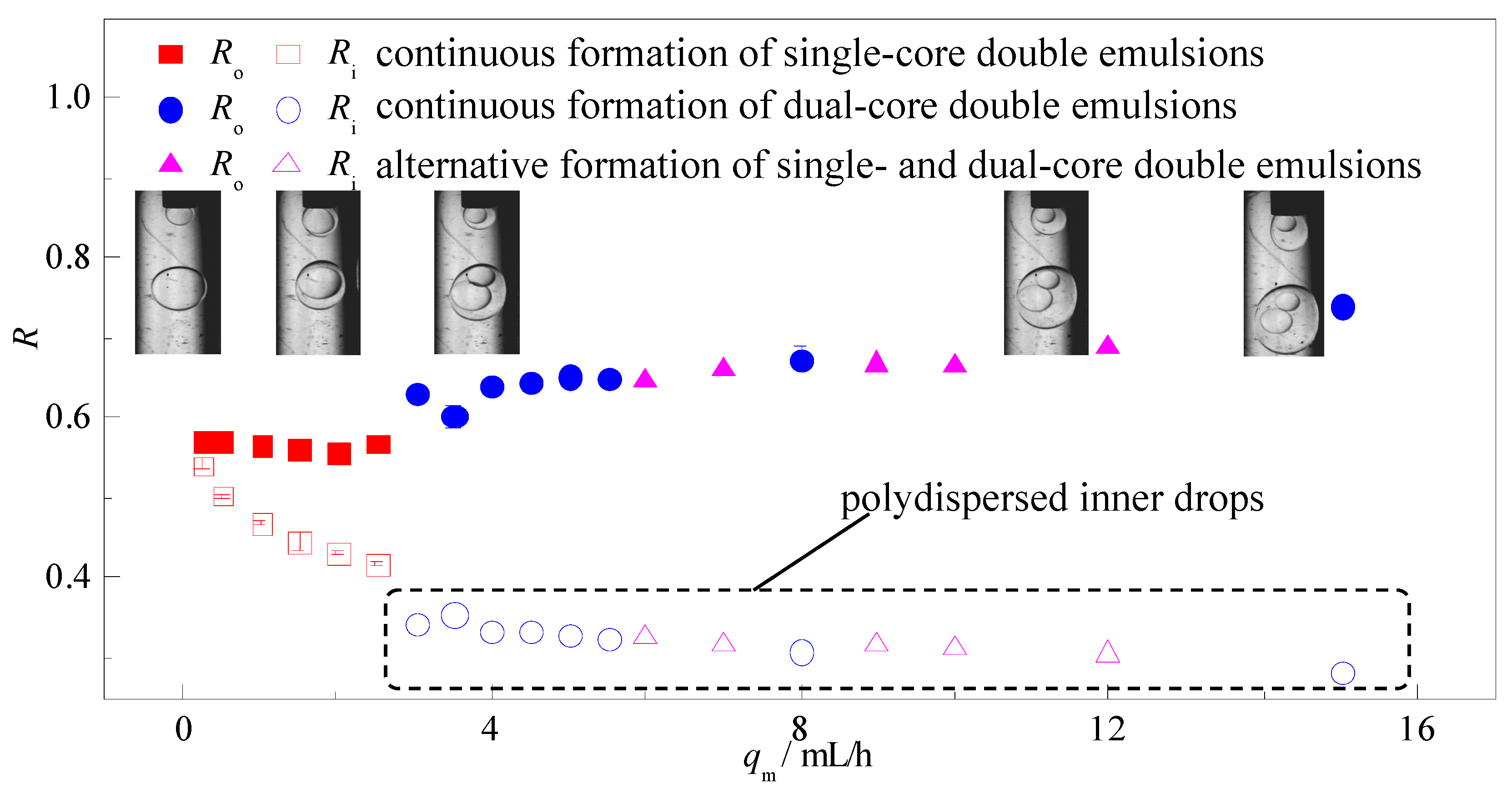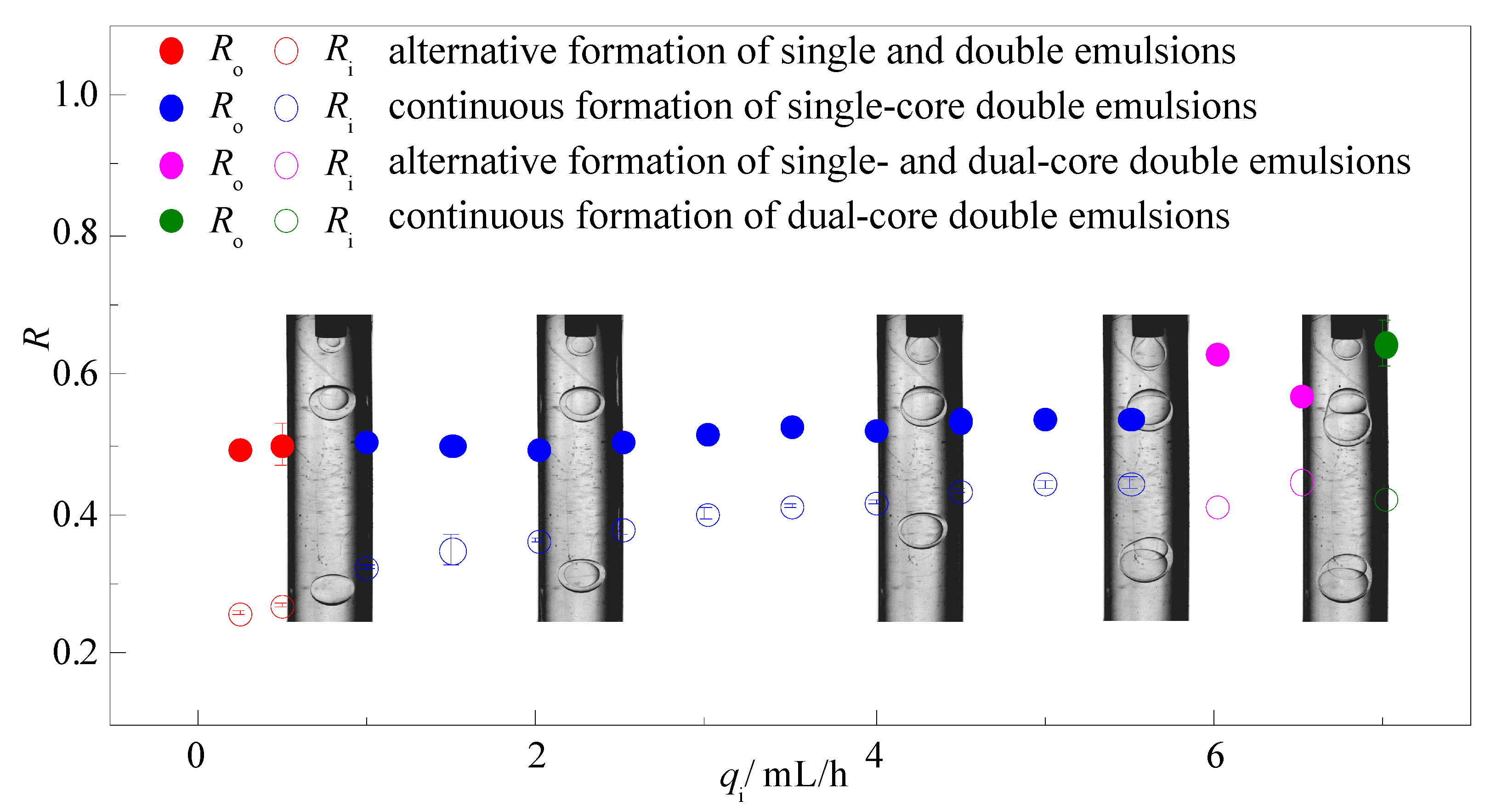To quantitatively describe the fluid dynamics during the formation of double emulsions, the distances from the front of the inner and outer interfaces to the outlets of the inner and middle fluid are measured as the lengths of the inner and outer drop (denoted as
li and
lo in
Figure 1) and nondimensionalized by the inner radius of the collecting PMMA tube
R3 as
Li =
li/
R3 and
Lo =
lo/
R3. Non-dimensional radii of the inner drop
Ri =
ri/
R3 and outer drop
Ro =
ro/
R3 are also measured to evaluate the dependence of drop size and size distribution on flow rates. The non-dimensional flow time is defined as
τ =
t/(
R1/
vi) where
vi =
qi/(π·
R12) is the mean velocity of the inner fluid and
qi is the flow rate of the inner fluid.
3.1. Continuous Production of Single-Core Double Emulsions
As demonstrated in
Figure 2, the formation of a single-core double emulsion drop can be divided into three stages: growth, separation of the inner drop, and separation of the outer drop. During the growth stage, the three fluids form two almost spherical interfaces that attach to the capillary tips indicating the leading role of interfacial tension. Both drop lengths
Li and
Lo increase with continuous injection of the fluids while
Lo increases slightly faster. The slight decrement of
Li and
Lo at first is caused by the retraction of the outer interface after the detachment of the last double emulsion drop. When the inner drop reaches a critical volume, the separation of the inner drop begins with a visible neck connect the inner drop with the tip of the inner capillary. Once the neck is formed, it shrinks rapidly under the effect of interfacial tension and eventually pinches off in a short time as shown in
Figure 2b. After that, a sphere inner drop is formed inside the outer drop. The viscous force from the middle fluid carries the inner drop downstream inside the outer drop and a neck is formed at the outer interface downstream of the inner interface (
Figure 2a,
τ = 28.8), indicating the separation of the outer drop. As plotted in
Figure 2b,
Lo turns up a discontinuous faster increment after the separation of the inner drop, attributed to enhancement of middle fluid flow caused by the detaching of the inner drop. Likewise, separation of the outer drop is also characterized by the shrinking of the neck and pinching off of the interface. Note that the outer interface squeezes the middle fluid upstream during pinching-off leading to the front of the inner interface been pushed backwards as shown in
Figure 2b. These interactions between the interfaces contribute to the radial growth of both inner and outer drops. After the detachment of the outer drop, sharp interfaces (
Figure 2a,
τ = 41.96–41.97) are retracted by the interfacial tension, lengths of both inner and outer drop decrease in a short period of time.
3.2. Continuous Production of Multi-Core Double Emulsions
Under the condition of low flow rate of the outer fluid, double emulsions with multi-cores (
Figure 3) can be produced by the co-flowing microfludic device. The variation of drop lengths
Lo and
Li indicate that the formation process of multi-core double emulsion can be divided into several stages: growth, separation of the first inner droplet, separation of the second inner droplet, separation of the
Nth inner droplet, and separation of the outer drop. The growth stage is similar as that during the formation of double emulsions with single core. However, due to the insufficient viscous force from the outer fluid which cannot overcome the interfacial tension of the outer interface, the outer drop continues growing after the detaching of the first, second, and (
N − 1)th inner drops. As plotted in
Figure 3b, except the first inner drop, the subsequent inner drops present similar growth and separation features. However, the detached inner drops still remain inside the outer interface leading to pressure increment inside the outer interface that each inner drop is formed under higher resistance than its previous one. Hence, the growing time of each inner drop is shorter than the previous one which leads to a comparatively smaller drop size compared to its previous inner drop. Since the growing and detaching processes of the inner drop are confined by the outer interface in our device, the afore detached inner drops accumulate inside the outer interface and squeeze each other including the growing interface at the tip of the inner capillary. As a result, the inner drops in the multi-core double emulsions generated by our device are polydispersed. Note that monodispersed multi-core double emulsions can be produced by two-step co-flowing microfluidic devices in which the inner drops are generated upstream by the first order co-flowing junction before entering the outer interface at the second co-flowing junction [
17]. However, surface wettability modification is required [
18] in the two-step devices to guarantee the correct fluid to be emulsified.
3.3. Alternative Production of Single and Double Emulsion
Apart from continuous production of double emulsions, alternative generation of monodispersed single and double emulsion drops is also observed when the flow rate of the middle fluid is much larger than the inner fluid. The drop formation processes are stable and robust with easy control of drop sizes, providing a novel approach for the manufacture of binary materials or dilution of the double emulsions. As shown in
Figure 4b, the growing of the inner drop is much slower compared to the outer drop, and the entire drop formation process can be divided as: first stage growth, separation of middle fluid drop, second stage growth, separation of inner drop, and separation of the outer drop. During
τ = 0–3.19, the faster growing outer drop reaches the critical volume while the inner drop is still growing. A neck on the outer interface develops downstream of the inner drop and the increasing of
Lo is slightly speed up when a single drop of the middle fluid without inner drop is detaching. During this stage, the variation of
Li fluctuates due to radial squeeze from the outer interface and the inner interface is stretched along the flow direction. After the first pinching-off, both inner and outer interfaces retract back to the tip of the capillaries and the process enters the second growth stage. The axial growth of both inner and outer drops slow down slightly while
Lo is still increasing much faster than
Li. It is worth noticing that the narrowest part of the outer interface is downstream of the inner drop (
τ = 9.31) when the outer drop begins detaching. However, this part of the interface does not develop into a neck. The pinching-off motion of the inner interface accelerates the fluid flow upstream and the inner drop is pushed through the narrow part of the outer interface. The neck on the outer interface is then developed upstream with the detached inner drop leading to the production of a double emulsion drop.
3.4. Influence of the Flow Rates
Figure 5 plots the variation of non-dimensional radii of both inner drop
Ri and outer drop
Ro with increasing flow rate of the outer fluid
qo. The statistics of size distributions of the drops are noted as the error bars in
Figure 5a. The results indicate that, multi-core double emulsions produced by the one-step device are polydispersed in both inner and outer drops and are only generated under the condition when the flow rate of the outer fluid is at the same magnitude with the middle and inner fluid. An example of the size distribution of the inner drops of multi-core double emulsions from a typical case is given in
Figure 5b. The size of the inner drops decreases with
qo slightly due to acceleration of the middle fluid caused by the momentum transfer from the outer fluid. Reduction of the number of inner drops is also observed, leading to drastic decrement on the size of the outer drop
Ro. With continuous growth of viscous force, the differences in time required for the inner drops and outer drops to reach critical volumes are lessened, hence generation of monodispersed single-core double emulsions occurs spontaneously. Increasing
qo results in smaller double emulsion drops, however, the variation of
Ro and
Ri follows the same tendency, which suggested that the increasing viscous force of the outer fluid has no obvious influence on the thickness of double emulsions produced in the one-step co-flowing device. When the flow rate of the outer fluid flow exceeds 180 mL/h, viscous force dominates over interfacial tension that single drops of middle fluid are sheared off between every other double emulsion drop. Under this flow condition, the double emulsions are still highly monodispersed while the single drops are polydispersed due to rupture of the interface repeatedly by the viscous force.
Compared to the outer fluid, the flow rate of the middle fluid
qm has decisive effect on the shell thickness (
Ro −
Ri) of the double emulsions and weaker influence on the double emulsion size. Ultra-thin shell double emulsions (see inset in
Figure 6) with polydispersity of less than 1% can be produced under low
qm and the drop size can be actively controlled by
qo. Also, the shell thickness can be adjusted from 5% to 50% of
Ro continuously by increasing
qm without causing large variation in the size of the double emulsions. A decrease in the inner drop size with
qm indicates that viscous force from the middle fluid plays critical role in the detaching process of the inner drop and controlling over the shell thickness. However, further increment in
qm over a threshold alters the number of inner drops and alternative formation of single-core and dual-core double emulsions can be observed. The outer drops are monodispersed while the inner drops are polydispersed due to the same reason in the formation of multi-core double emulsion. Hence, to achieve steady production of monodispersed single-core double emulsions as well maintain better control over the formation process, the flow rate of the middle fluid should be kept at the same magnitude or smaller than the inner fluid.
Similar to the middle fluid, variation of the flow rate of the inner fluid
qi has no obvious influence on the drop size of the double emulsions as shown in
Figure 7. Under the condition of low
qi, insufficient inner fluid leads to alternative formation of monodispersed single and double emulsions that each take up to 50% percent. As
qi increases, continuous formation of single core double emulsions can be observed in a wide range that the inner drop size increases slightly with
qi while the outer drop size remains almost constant. Besides, the shell thickness can only be adjusted in a narrower range by the inner fluid compared to the middle fluid. However, after the increment of
qi over a threshold, alternative formation of single-core and dual-core double emulsions can be observed with high polydispersity, indicating that low flow rate of the inner fluid is required to obtain steady production of monodispersed double emulsions.
